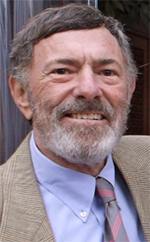The Life of Tony Trabert
Part 5
Mark Winters
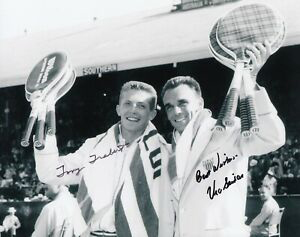
Though he hadn't played a competitive match in five years, Tony Trabert focused on preparing for a return in 1968. At 38, after all he had accomplished, he still had the drive. He wanted to have his name in the record book as a participant in the first US Open.
At Forest Hills he teamed with Vic Seixas. In the first round they received a walkover against the John de Zeeuw of South Africa and Roberto Marcher of Brazil. In their second match, Tom Okker of the Netherlands and Marty Riessen, the No. 5 seeds won 3-6, 6-1, 8-6.
Hall of Fame
In 1970, Trabert received the ultimate recognition. He became a member of the International Tennis Hall of Fame. At the time, only 64 of the game's most significant individuals had been so honored. In his case, there was more to his selection than his superlative 1955 showing. Always thoughtful and always well-spoken, interviews from the 1950s make it very clear what made him so exceptional. Here are a few Trabert Truisms.
He wasn't the most talented or quickest player, but he focused on making all of his strokes sound so that he didn't have a weakness. He could consistently compete at a high level and maintain it. He didn't have ups and downs.
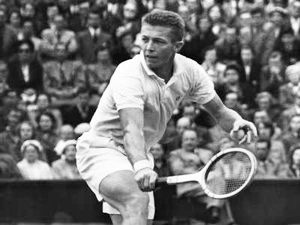
He was not boastful. He was confident and proud of the commitment he made to become a champion. At the same time, he was keenly aware, when competing, of the importance of balancing strengths and weaknesses.
His mantra was – win quickly – nothing bad can happen to you in the locker room.
He didn't count wins. All that was important were championships.
Of all his strengths one that wasn't regularly touted was his mental strength. Insiders admitted that his mind was his greatest asset.
The year he was honored at the Hall in 1970, Trabert played the US Open with Dick Savitt. He was 40 and Savitt was 43.
They defeated Sutarjo Sugiarto and Atet Wijono of Indonesia, 3-6, 7-6, 6-4, 3-6, 6-3 in the first round and received a second round walkover from the Brazilian duo Thomaz Koch and Marcher. Charlie Pasarell and Erik van Dillen defeated them in the third round, 6-3, 6-3, 6-4.
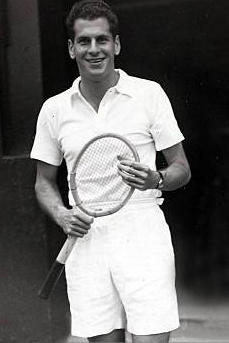
As good as the previous year was, 1971 was more fulfilling for Trabert. He embarked on a career as a CBS tennis and golf analyst. For 30 years, most of which he teamed with Pat Summerall, the former New York Giants football player, he was the voice of US Open television broadcasts. In addition, for over 20 years he was a member of the Australian Channel 9 team at Roland Garros and Wimbledon.
Tony Trabert Tennis Camp
The Tennis Boom in the US originated in the 1970s. Trabert took advantage of the trend and launched the Tony Trabert Tennis Camp at The Thatcher School--whose most noted alumnus then was Howard Hughes-- in Ojai, California. It was located at the base of the Los Padres National Forest. At the time, it was a private boys boarding school. More important, it had dormitories and ten tennis courts. (As an aside, Ojai means "Moon" which comes from the Chumash Tribe's language.)
At the time, I was a fledgling journalist who was freelancing tennis along with wine and travel stories, as well as coaching. Basically, I was deciding what I was going to be when I grew up. As mentioned, I had met Trabert in the ‘60s. Our paths had crossed from time to time until the spring of 1971 when he offered me a position at the camp.
Annually for many years, thereafter, I lived, for ten weeks in the early summer, when the weather was very warm, at Thatcher. A week was spent getting to know the staff and going over the Trabert way of teaching. Three three-week camp sessions followed that and were open to youngsters from ages nine to 18.
Because of his presence and his easygoing manner, Trabert was an icon and that was the reason students came from across the US as well as around the world. Unlike many "name camps" where the "name" was rarely on hand, Tony was always there.
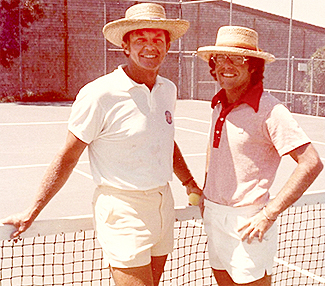
What's more, his approach to teaching didn't require instructors or students to understand the complexity of the inverse angle of a hypotenuse or for that matter any mathematical gradients. He believed the simpler, the better.
It was all a matter of getting the racquet head and hand behind and below the ball and lifting it over the net. The more movement and flourishes that were added, the more errors could result.
In his dealings with the campers, parents and staff, he was honest, sincere and had a wicked sense of humor. Trabert dealt with people with big money, who sent their children to camp, the same way he did with those who just wanted their youngster to develop a fundamental foundation for his/her game, with concern and care.
Favorite Uncle?
It was almost as if he was a favorite uncle when it came to his manner of communicating. What he said didn't require an interpreter. His words had meaning.
Yet, thinking back – I still marvel. He was completely egoless. I really believe that those who attended the camps, along with many on the staff, didn't fully comprehend how great a player he was. To everyone, he was "Tone" or "T2" and he was perfectly comfortable with that.
I, in turn, was "Marko" and reviewing mental images from those days always results in good feelings. The second Sunday of every camp session was "Parents Day" when fathers and mothers would visit.
Some had significant celebrity or business status. Many were just "folks". Most everyone wanted to play doubles with or against Trabert. Occasionally, recent college graduates, who had a brother or sister attending the session and seemed to have majored in tennis, would appear. They would strut around the doubles court anxious to take on The Master and to prove they were, indeed, players.
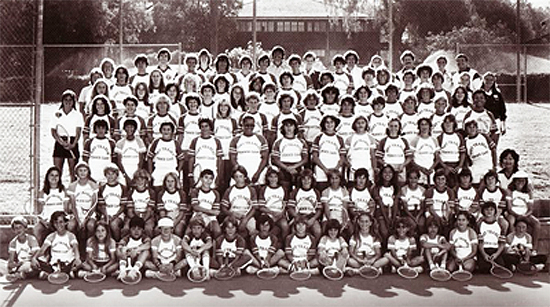
It was a foolish move. I never, in all the years that I played with him in these matches, understood why "ego overwhelmed sensibility". Trabert was so comfortable with who he was, and his game was so complete, he would simply enjoyed the moment…then hit another winner.
On one occasion, we were warming up and I had been attempting to "lift" the ball, so I didn't drive a barrage of pre-match shots into the net. I had been accomplishing the task, carrying many groundstrokes a foot or so over the baseline.
After we had taken our warm-up serves, Tone turned to me and with a sly grin said, "Marko, you have been getting good depth on your groundies. But, when we play, it is okay to hit them inside the white lines."
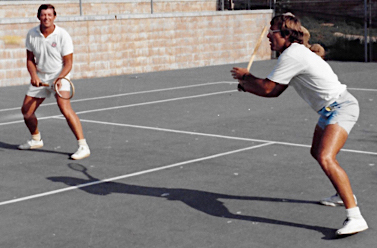
I guess I had been tight because I didn't want to embarrass him by knocking down the net as we got loose. His comment, though, cracked me up and I had a relaxing laugh. As, it turned out, we won that match handily no thanks to me.
What's more, he could still "play". In fact, at the 1972 US Open, he and Seixas lost a tough 6-4, 6-4, 4-6, 6-3 contest to Savitt and Sammy Giammalva, Sr. at Forest Hills and this was after preparing by playing doubles every day, during the campers rest period, with one of the counselors against me and another instructor.
When talk turns to the best backhand of all-time, many purists continue to claim that Don Budge's was the best. Stan Wawrinka of Switzerland and Richard Gasquet of France have also been recognized.
Tony's Backhand
But, for me Trabert's was top of the line. I wasn't bad at doubles primarily because off the ad side of the court I could crease cross-court backhand serve returns. Nonetheless, before playing camp visitors, we had a regular routine.
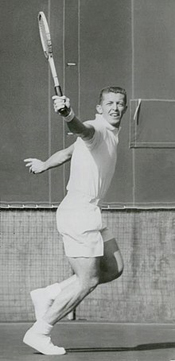
I smile as I write this. Tone would say, "You know, Marko you have a great forehand so I think you should play the deuce side against these guys…and the first time they serve to your backhand hit it down-the-line at the net man…that will send a message. Then I will see what I can do."
Of course, he kindly overlooked the fact that my going inside out on a backhand return from that side of the court was something that I had to pray to accomplish, while his play off the ad side of the court was unmatched.
The Thatcher campus is 427 acres in a rustic area covered in trees, grass and wild plants. There was plenty of "territory" for youngsters to explore during their three-week visits.
They were warned the first evening at Introductory Night about curfew, daily rest hour and mealtimes. There were a few other rules, foremost of which was staying out of the forest that surrounded the camp because the poison oak and nettles were hazardous. This was stressed again and again.
Yet, for countless campers, the forest became the "it will not happen to me challenge". On one occasion, a teenage boy and girl were immediately smitten when they checked into camp. They became inseparable, so it was hardly a surprise that they went exploring.
The boy ended up with poison oak all over his body and spent the entire three weeks in the infirmary. She didn't get a case as serious, so her tennis was only somewhat limited. But to me it was hardly a surprise that when Trabert learned about the result of the "hike" in tennis shorts, he told the youngster he could attend the second session at no cost so he could actually play some tennis and stop being slathered in Calamine lotion.



